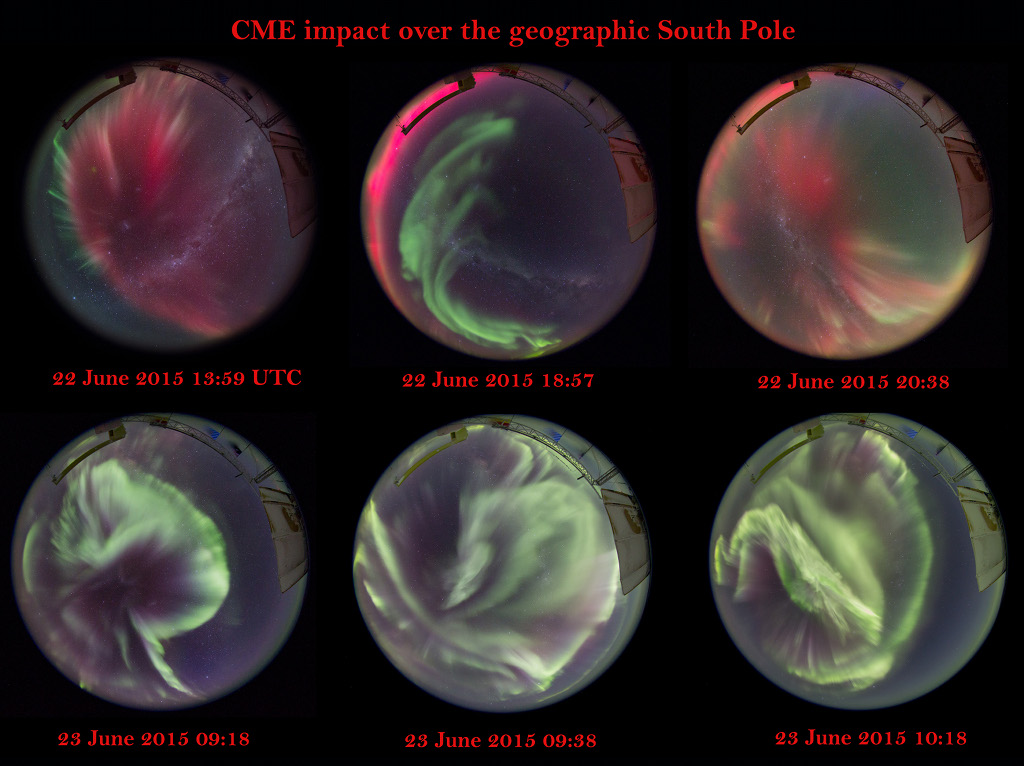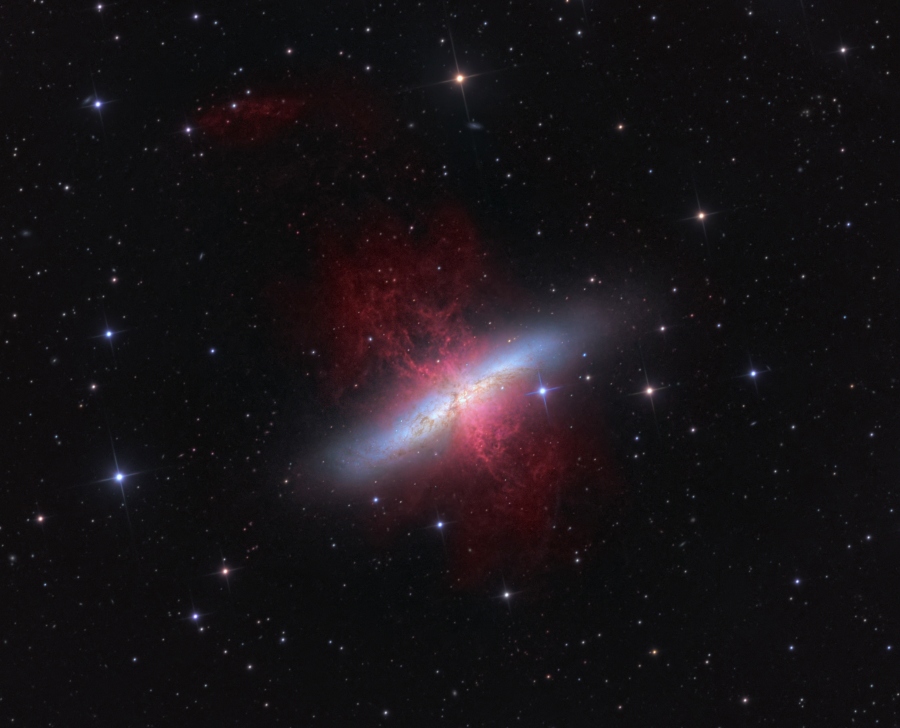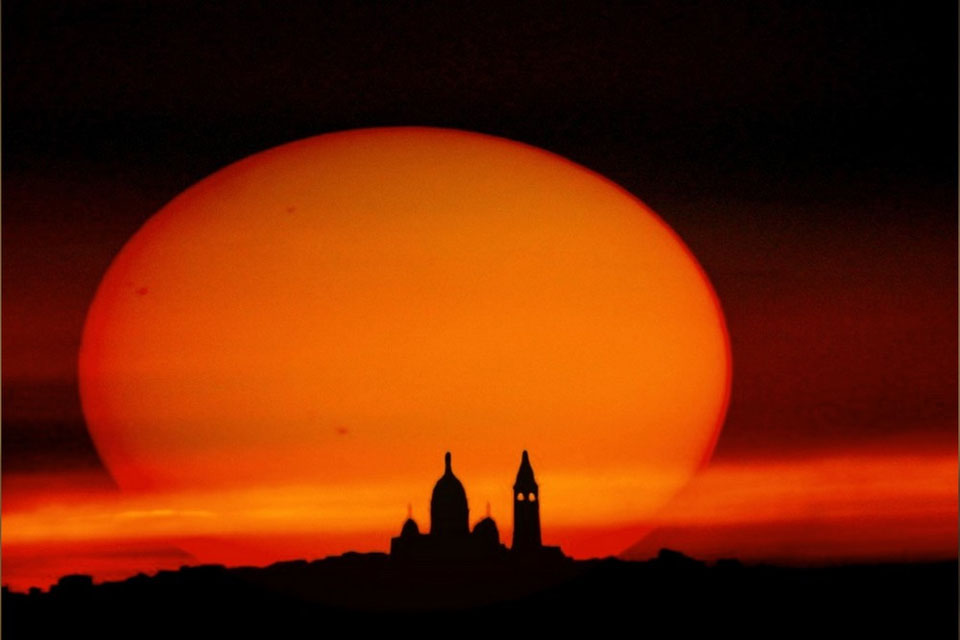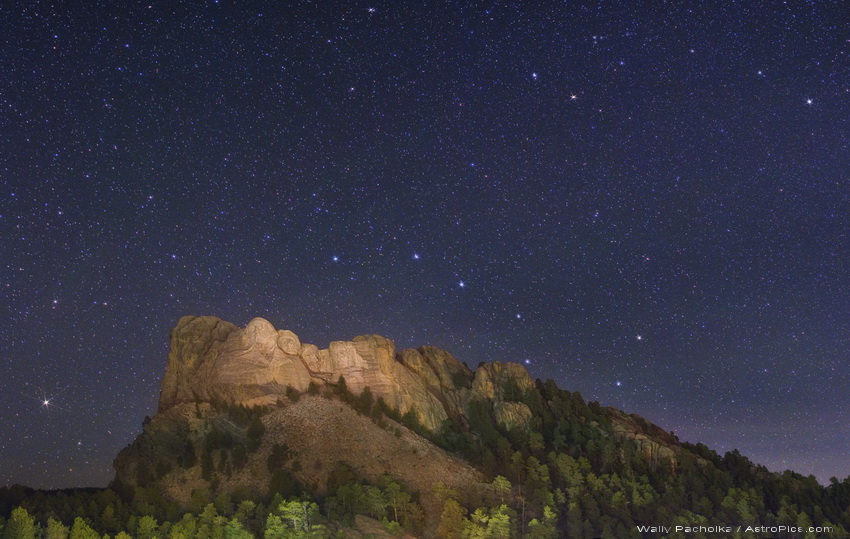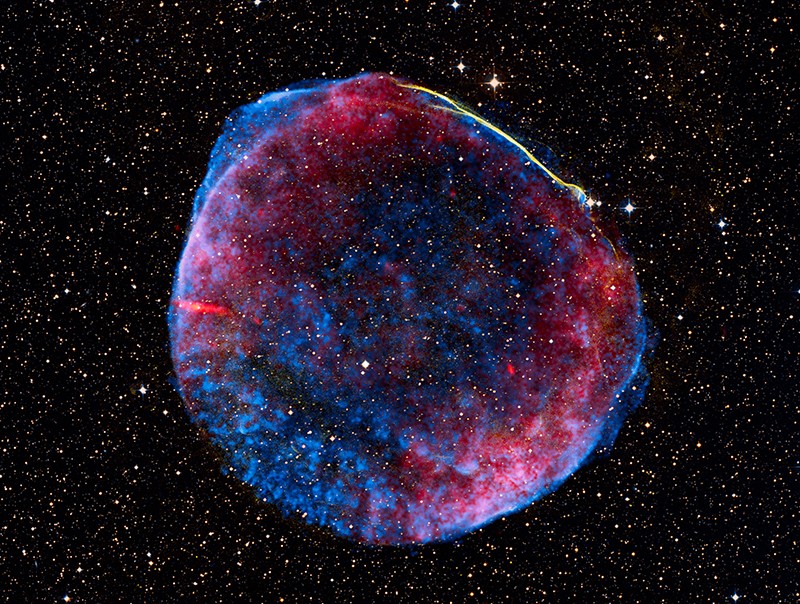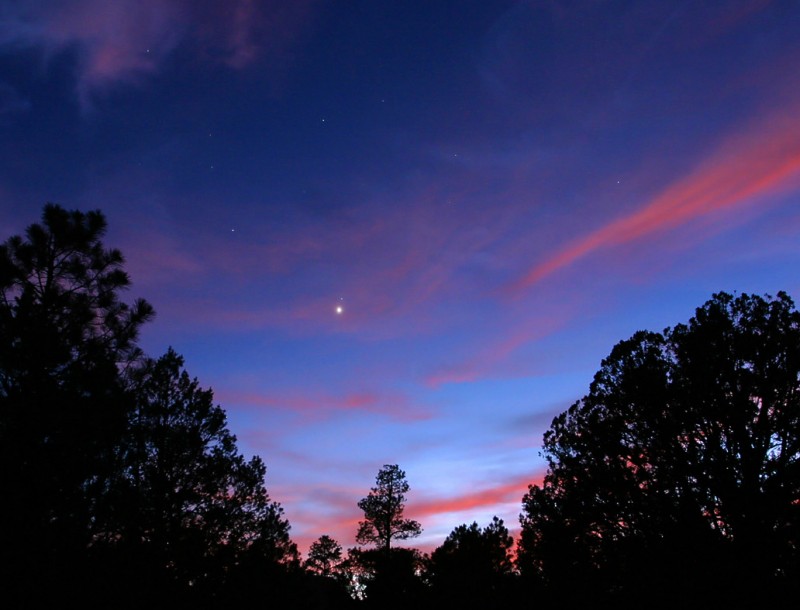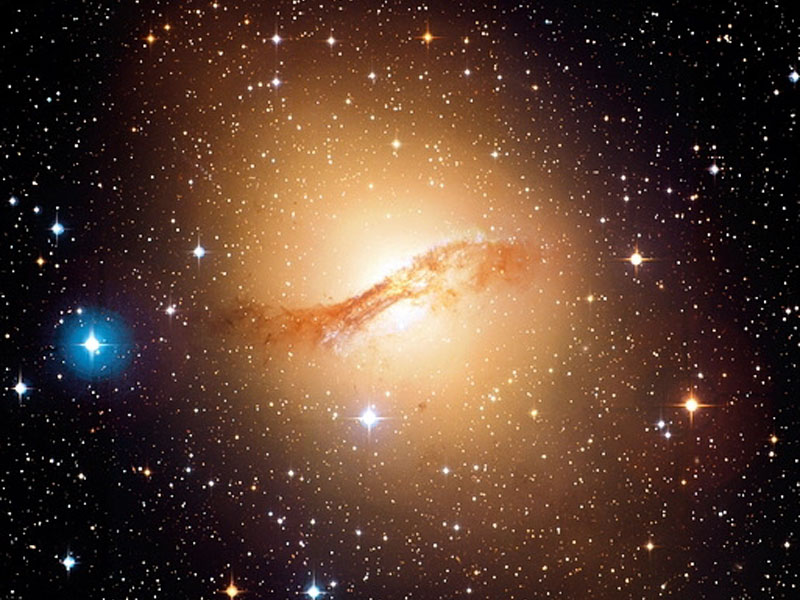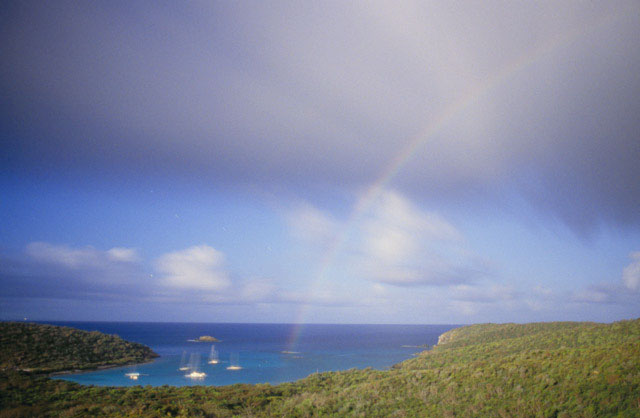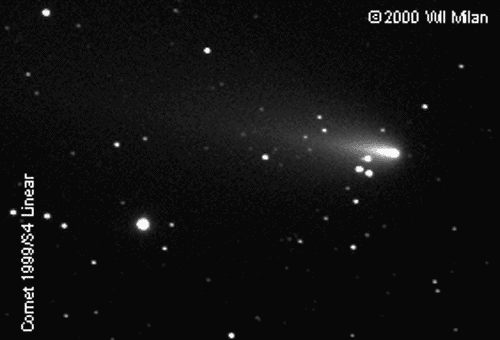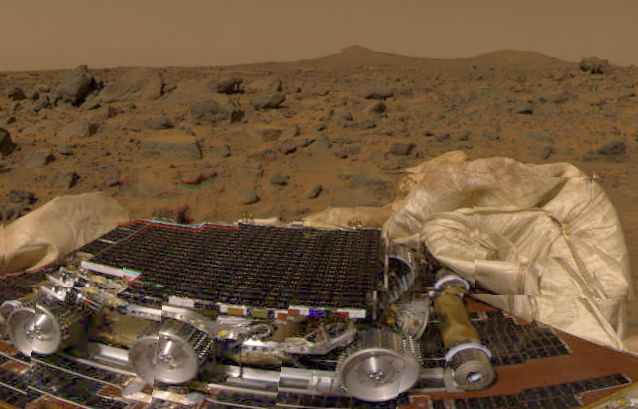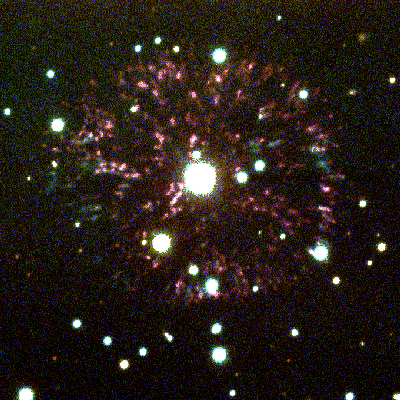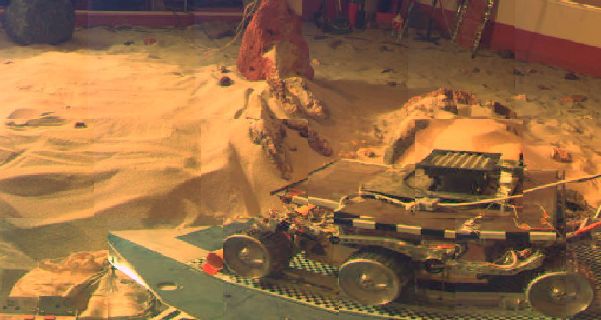| << Previous | Index | Next >> |
2015 Not fireworks, these intense shimmering lights still danced across Earth's night skies late last month, seen here above the planet's geographic south pole. The stunning auroral displays were triggered as a coronal mass ejection blasted from the Sun days earlier impacted the magnetosphere, beginning a widespread geomagnetic storm. The six fisheye panels were recorded with digital camera and battery in a heated box to guard against -90 degree F ambient temperatures of the long winter night. Around the horizon are south pole astronomical observatories, while beyond the Aurora Australis stretch the stars of the southern Milky Way.
2014 In this alluring time exposure, star trails arc across the night sky above foggy Monterey Bay and the lights of Santa Cruz, California in the United States of America. Since the exposure began around 2:56am PDT on July 2 it also records the trail of a Delta II rocket lofting NASA's OCO-2 spacecraft into orbit. Seen from a vantage point 200 miles north of the Vandenberg Air Force Base launch site, the trail represents the first five minutes of the rocket's flight along a trajectory south and west over the Pacific to join the A-Train in polar orbit around planet Earth. The entire trail through main engine cut-off is captured, with a very faint puff at the end marking the nose fairing separation. Under the rocket's path, the two brightest trails are the alpha and beta stars of the constellation Grus, flying high in southern skies. The OCO-2 mission goal is a study of atmospheric carbon dioxide, watching from space as planet Earth breathes.
2013 Also known as the Cigar Galaxy for its elongated visual appearance, M82 is a starburst galaxy with a superwind. In fact, through ensuing supernova explosions and powerful winds from massive stars, the burst of star formation in M82 is driving a prodigious outflow. Evidence for the superwind from the galaxy's central regions is clear in this sharp telescopic snapshot. The composite image highlights emission from long outflow filaments of atomic hydrogen gas in reddish hues. Some of the gas in the superwind, enriched in heavy elements forged in the massive stars, will eventually escape into intergalactic space. Including narrow band image data in the deep exposure has revealed a faint feature dubbed the cap. Perched about 35,000 light-years above the galaxy at the upper left, the cap appears to be galactic halo material. The material has been ionized by the superwind shock or intense ultraviolet radiation from the young, massive stars in the galaxy's core. Triggered by a close encounter with nearby large galaxy M81, the furious burst of star formation in M82 should last about 100 million years or so. M82 is 12 million light-years distant, near the northern boundary of Ursa Major.
2012 What stands between you and the Sun? Apparently, as viewed from Paris last week, one visible thing after another. First, in the foreground, is the Basilica of the Sacred Heart, built in the late 1800s and located on the highest hill in Paris, France. Next, well behind the basilica's towers in the above image, are thin clouds forward scattering sunlight. Finally, far in the distance and slightly buried into the Sun's surface, are sunspots, the most prominent of which is sunspot region AR 1512 visible near the disk center. Since the time that this sunset image was taken, the sunspot region on the far left, AR 1515, has unleashed a powerful solar flare. Although most particles from that flare are expected to miss the Earth, sky enthusiasts are on watch for Sun events that might cause bright auroras in an invisible thing that stands between you and the Sun: the Earth's atmosphere.
2011
Image Credit & Copyright: Alex Cherney (Terrastro); Music: Redmann
2010 The first direct image of an extrasolar planet orbiting a star similar to our Sun has been confirmed. Located just 500 light-years away toward the constellation Scorpius, the parent star, cataloged as 1RXS J160929.1-210524, is only slightly less massive and a little cooler than the Sun. The star is, however, much younger, a few million years old compared to the middle-aged Sun's 5 billion years. This sharp infrared image shows the young star's planetary companion positioned above and left of center. The planet is estimated to have a mass about 8 times the mass of Jupiter, and orbit a whopping 330 times the Earth-Sun distance from its parent star. The young planetary companion is still hot and relatively bright in infrared light, likely due to the heat generated during its formation by gravitational contraction. In fact, such newborn planets are easier to detect before they age and cool and become much more faint. The discovery image, shown above, was taken in 2008 but confirmed only recently by noting that the planet stayed with its parent star as background stars slightly shifted over time.
2009 This starry night sky sparkles above the Black Hills of South Dakota and the United States' Mount Rushmore National Park. The historic site features enormous sculptures of four US presidents; George Washington, Thomas Jefferson, Theodore Roosevelt and Abraham Lincoln, carved into the southeast face of granite cliffs. Above the monumental symbols of the country's independence and early history, the night features stars and constellations familiar to northern skygazers around the world. Most noticeable are the stars of Ursa Major and the asterism known as the Big Dipper, almost resting upright along the cliff edge near picture center. Follow the arc of the Big Dipper's handle to get to Arcturus, the bright yellowish star in the lower left corner. Of course, a line extending through the dipper's two right most stars points to the upper right toward Polaris, planet Earth's North Star.
2008 A new star, likely the brightest supernova in recorded human history, lit up planet Earth's sky in the year 1006 AD. The expanding debris cloud from the stellar explosion, found in the southerly constellation of Lupus, still puts on a cosmic light show across the electromagnetic spectrum. In fact, this composite view includes X-ray data in blue from the Chandra Observatory, optical data in yellowish hues, and radio image data in red. Now known as the SN 1006 supernova remnant, the debris cloud appears to be about 60 light-years across and is understood to represent the remains of a white dwarf star. Part of a binary star system, the compact white dwarf gradually captured material from its companion star. The buildup in mass finally triggered a thermonuclear explosion that destroyed the dwarf star. Because the distance to the supernova remnant is about 7,000 light-years, that explosion actually happened 7,000 years before the light reached Earth in 1006. Shockwaves in the remnant accelerate particles to extreme energies and are thought to be a source of the mysterious cosmic rays.
2007 Contrasting colors in this beautiful sunset sky were captured on June 30 from Clear Creek Canyon Observatory in central Arizona, USA. The twilight scene includes brilliant Venus as the evening star, with a bright Saturn just above it, shining through thin clouds. The two wandering planets were a mere 1 degree apart or so, about twice the width of the full Moon rising above the eastern horizon on the other side of the sky. In fact, such serene skyviews were possible from all over planet Earth as Venus and Saturn approached a conjunction. Regulus, alpha star of the constellation Leo, is above and to the left of the close planetary pairing. At dusk, lights in tonight's sky will also feature Venus and Saturn low in the west and separated by about 2 degrees.
2006
2005 Typically, views from Mauna Kea are up and dark. That's because the famous dormant volcano in Hawaii is arguably Earth's premier observing platform of the complex and ever changing night sky. However, this daytime view is across and bright. White snow and white clouds seem to blend together to make an alien landscape. Cinder cones from extinct volcanic outbursts dominate the foreground. Scrolling right will reveal structures visually incongruous even here: an armada of the largest optical telescopes on Earth. The observatories seen include Subaru and Keck. In the distance on the far left is Mauna Loa, Earth's largest volcano.
2004 Except for the rings of Saturn, the Ring Nebula (M57) is probably the most famous celestial band. This planetary nebula's simple, graceful appearance is thought to be due to perspective -- our view from planet Earth looking straight into what is actually a barrel-shaped cloud of gas shrugged off by a dying central star. Astronomers of the Hubble Heritage Project produced this strikingly sharp image from Hubble Space Telescope observations using natural appearing colors to indicate the temperature of the stellar gas shroud. Hot blue gas near the energizing central star gives way to progressively cooler green and yellow gas at greater distances with the coolest red gas along the outer boundary. Dark, elongated structures can also be seen near the nebula's edge. The Ring Nebula is about one light-year across and 2,000 light-years away in the northern constellation Lyra.
2003 Scattered debris from a cosmic supernova explosion lights up the sky in this gorgeous composited image based on data from the Hubble Space Telescope. Cataloged as N49, these glowing filaments of shocked gas span about 30 light-years in our neighboring galaxy, the Large Magellanic Cloud. Light from the original exploding star reached Earth thousands of years ago, but N49 also marks the location of another energetic outburst -- an extremely intense blast of gamma-rays detected by satellites on March 5, 1979. That date was the beginning of an exciting journey in astrophysics which led researchers to the understanding of an exotic new class of stars. The source of the "March 5th Event" is now attributed to a magnetar - a highly magnetized, spinning neutron star also born in the ancient stellar explosion which created supernova remnant N49. The magnetar hurtles through the supernova debris cloud at over 1,200 kilometers per second.
2002
[imghover6=http://apod.nasa.gov/apod/image/0207/ng ... a-02sm.jpg]http://apod.nasa.gov/apod/image/0207/ng ... b-02sm.jpg[/imghover6]Credit T. H. Puzia (Sternwarte Munich), S E. Zepf (Yale / Michigan State) et al., ESO, ESA, NASA
2001 Have you ever seen a moonbow? Just as rainbows are lit by the Sun, moonbows are lit by the Moon. Since the Sun is so much brighter than the Moon, sunlit rainbows are much brighter and more commonly seen than moonbows. Pictured above is a moonbow stretching over Salt Pond Bay in St. John, Virgin Islands. Sailboats are visible on the left. To bring out the moonbow, an exposure of 30 seconds was needed, making the picture appear as if it was taken during the day. Since moonlight is itself reflected sunlight, the colors are nearly the same. Both rainbows and moonbows are created by light being scattered inside small water droplets, typically from a nearby rainfall. The raindrops each act as miniature prisms, together creating the picturesque spectrum of colors seen.
2000 Just possibly, a new comet may become bright enough to see without binoculars later this month. Comet C/1999 S4 LINEAR is rapidly approaching both the Earth and the Sun from the outer Solar System, and should be at its brightest around 2000 July 25 in the early evening sky of northern observers. The comet was discovered by chance by project LINEAR last September. The above time-lapse sequence of Comet LINEAR was taken on 2000 July 2 from Arizona and shows the comet's movement over only 19 minutes. Although Comet LINEAR's positions will be known quite accurately, the comet's future brightness and tail length can only be guessed, and it is quite possible that neither will become very impressive.
1999 On July 4th, 1997 - using its own array of fireworks, a parachute, and airbags - the Mars Pathfinder spacecraft successfully came to rest on the surface of Mars at 10:07 AM Pacific Daylight Time. Ninety minutes before reaching the surface Pathfinder began a flurry of activity. The robot spacecraft vented cooling fluid, jettisoned its cruise stage, decelerated at 20 gees on atmospheric entry, deployed a 24 foot parachute, jettisoned its heat shield, slid down a 60 foot bridle, fired solid fuel braking rockets, deployed a cocoon of airbags, separated from the bridle, impacted the martian surface, bounced a few times (traveling about 300 - 600 feet between bounces), settled on the surface, deflated the airbags, and righted itself, all under the autonomous control of the onboard computer. Above is a mosaic of images transmitted shortly after Pathfinder reestablished communication with its operators on Earth. The solar powered, two foot long, 25 pound Mars Sojourner robot rover is visible crouched on the unfolded spacecraft. Beyond lie deflated airbags, rock-strewn terrain, distant hills, and a dusty brown martian sky.
1998 Imaged by the WIYN Telescope, the Firework Nebula is the result of a type of stellar explosion called a nova. In a nova, a nuclear detonation on the surface of a compact white dwarf star blasts away material that has been dumped on its surface by a companion star. Also known as GK Persei or Nova Persei, this nova became one of the brightest stars in the night sky in the year 1901. As it faded, astronomers could see an expanding shell of gas that eventually became this spectacular nebula. While not exactly predictable, GK Per undergoes minor outbursts every three or four years.
1997 Today, July 4th, at about 10:00 AM Pacific Daylight Time (PDT), the Mars Pathfinder spacecraft will land on Mars. Ninety minutes before reaching the surface Pathfinder will begin a flurry of activity. The robot spacecraft is scheduled to vent cooling fluid, jettison its cruise stage, decelerate at 20 gees on atmospheric entry, deploy a 24 foot parachute, jettison its heat shield, slide down a 60 foot bridle, fire solid fuel braking rockets, deploy a cocoon of airbags, separate from the bridle, impact the martian surface, bounce a few times (traveling about 300 - 600 feet between bounces), settle on the surface, deflate the airbags, right itself, deploy its landing petals, and resume communication with planet Earth, all under the autonomous control of the onboard computer. If all goes well, at about 4:30 PM PDT the Pathfinder's camera "IMP" will spring into action recording frame by frame a panoramic view of the surface. Dubbed "Mission Success" the mosaic above is a laboratory simulation of the planned first image sequence to be downlinked from the surface of Mars.
1996 Three thousand light years away, a dying star throws off shells of glowing gas. This image from the Hubble Space Telescope reveals "The Cat's Eye Nebula" to be one of the most complex planetary nebulae known. In fact, the features seen in this image are so complex that astronomers suspect the bright central object may actually be a binary star system. The term planetary nebula, used to describe this general class of objects, is misleading. Although these objects may appear round and planet-like in small telescopes, high resolution images reveal them to be stars surrounded by cocoons of gas blown off in the late stages of stellar evolution.
1995 The Firework Nebula, known to astronomers as "GK Per", is the result of a type of stellar explosion called a nova. In a nova, a very compact star called a white dwarf blasts away gas that had accumulated on its surface. In this case the nova occurred in the year 1901 and is called Nova Persei 1901. This nova became as bright as one of the brighter stars we see in the night sky, but then faded until only a telescope could see it. Soon astronomers could see an expanding shell of gas that eventually became this spectacular nebula. The unusual "fireworks" type feature of this nebula is still a matter of research and discussion.
| << Previous | Index | Next >> |
